Schrade Radok pivot lock folder is a folding knife by Schrade. It is an American cutlery company founded by George Schrade that eventually became part of a conglomerate with five other cutlery brands and became Imperial Schrade in 1985.
George Schrade’s journey started in 1892 when he first developed, designed and patented his first ever push button automatic knife becoming the ‘father of the automatic knife.’ He patented his next knife in 1907 with a sliding safety switch. He established his company in 1904 and spent four decades bringing innovation to his designs before passing away in 1940. But his work remains relevant even after his passing and became a dominant force in the US switchblade market before the sale of switchblade knives were outlawed by the Congress in 1958.
However, in 2004, after celebrating its 100th anniversary, it had to close its Ellenville factory laying off all its workers. The bankruptcy wasn’t far behind after that. Taylor Brands then took over Imperial Schrade and continued making Uncle Henry Knives and Old Timer, including the Imperial knives.
Then 12 years later, Battenfield Technologies bought Taylor Brands in 2016 and came up with a new branding strategy for Schrade’s line of knives last year in 2022. It categorized Schrade knives into Alpha and Beta with a good-better-best knives division for high-quality premium knives. The Radok is one of them.

Schrade Radok Review
The Schrade Radok is a proud member of the Schrade Alpha category with CPM S35VN Wharncliffe Flat Blade, Carbon Fiber Handle, Pivot Locking Mechanism and Ultra Glide Technology. It extends as much as 8.75” with a blade length of 3.75”, a standard blade thickness of 0.125”, a handle thickness of 0.5” and weighs 4.5 oz. It comes with a well-defined satin finish.
Key Specifications of Schrade Radok
S35VN Blade of Schrade Radok
The blade of Schrade Radok looks enormous when held. It has a spine thickness of 0.10” and measures 3.75” long. It has a long curving spine with a slight belly, more suitable to be called a modified Wharncliffe blade shape.
Along the forward spine section, there is a large false edge with a visible thumb ramp along aggressive jimping lines. There is also a peak at the end of the thumb ramp with a short primary edge grind. It makes the blade geometry too thick and large for comfort.
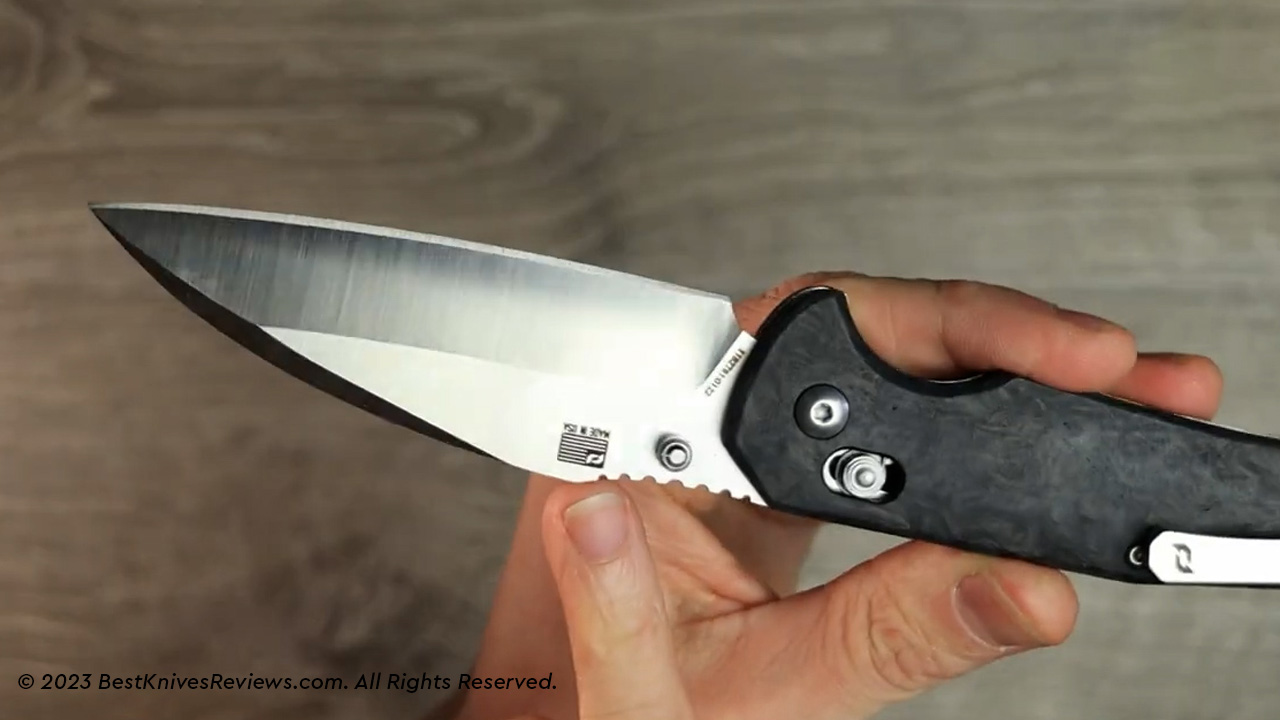
The sharpening choil is also quite short on this blade with edge grind transitions that plunge diagonally with it at the edge of the blade. The blade is also poorly proportioned in comparison to the handle. It does not go well with it. Although it is good for punching holes and opening packages, the blade does not sit well when closed. It sticks out even when it is in a locked position
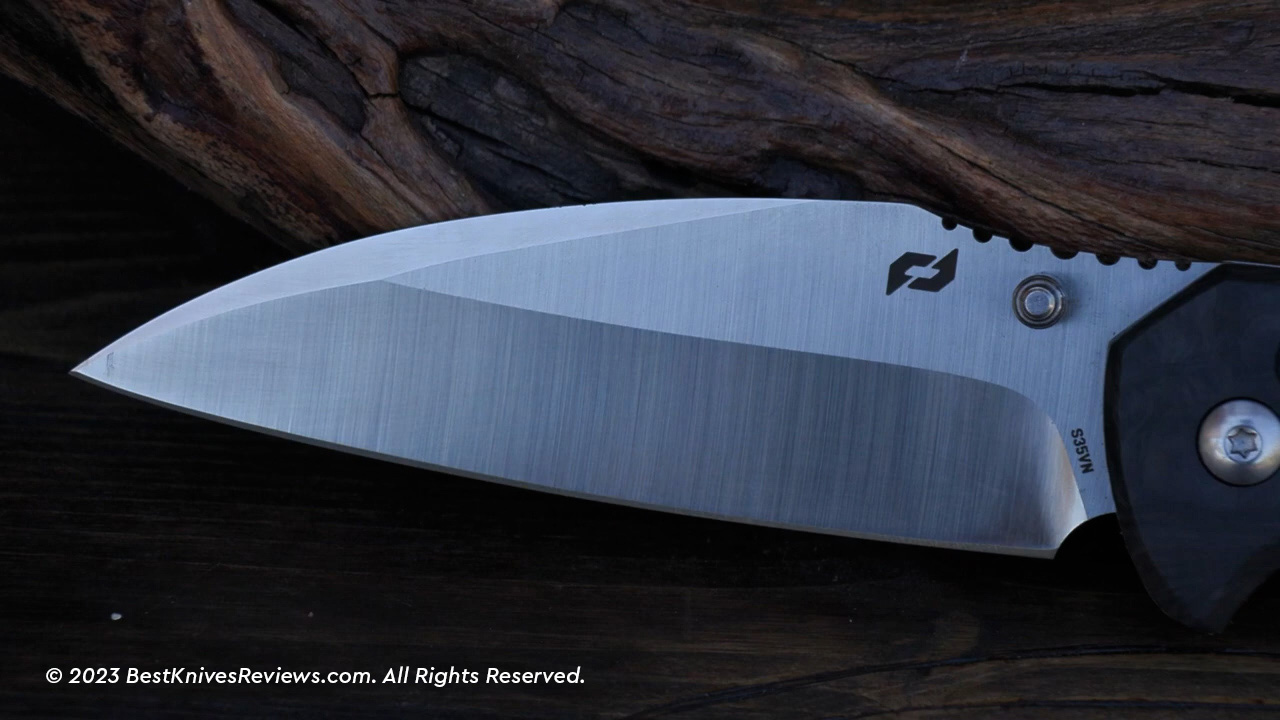
Although CPM S35VN is a great premium quality blade, it does not work well on this knife and at this price point. If only it was strategically placed and in line with the handle, it would have turned out great. It is made with powdered metallurgy with cleaner edge and finer grain structure. It could have been put to better use at this price, or a different blade could have been used on it. It has excellent edge retention and corrosion resistance compared to S30V. It is tougher, resistant to chipping and easy to machine manufacture. It has vertical flat grind lines with a satin finish.
Handle Ergonomics of Schrade Radok
Schrade Radok comes with carbon fiber handle, a fidget-friendly pivot and lock and a sculpted pocket clip. The scales are marbled, deep and lustrous to look at. The edges are contoured for a comfortable grip, but only up to 50%.
If you look at the scale’s liners, they’re too wide for a lanyard hole to pass through. The corners of that hole are too pointy and edgy, not to mention the lanyard hole itself being too small. The pointy edges pinch into your palm every time you try to open and close the knife.
Moreover, the jimping across the thumb hole is too aggressive for comfort. It is also not comfortable. It will dig into your thumb if you press into it too harshly. Therefore, the ergonomics on this knife are not ideal.
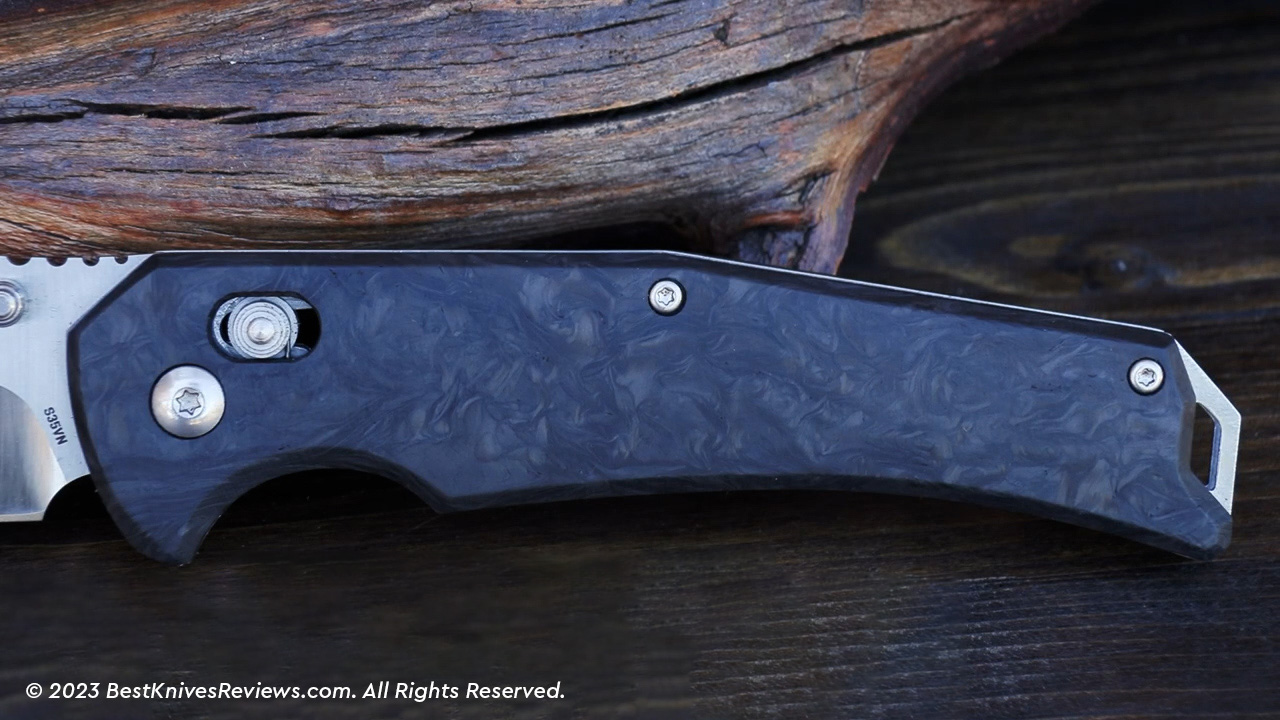
The jimping on the thumb ramp also pinched into the thumb and was not as smooth. It also hindered in our efforts for creating precise cuts. The handle also felt heavier than the blade, which again affected its cutting performance.
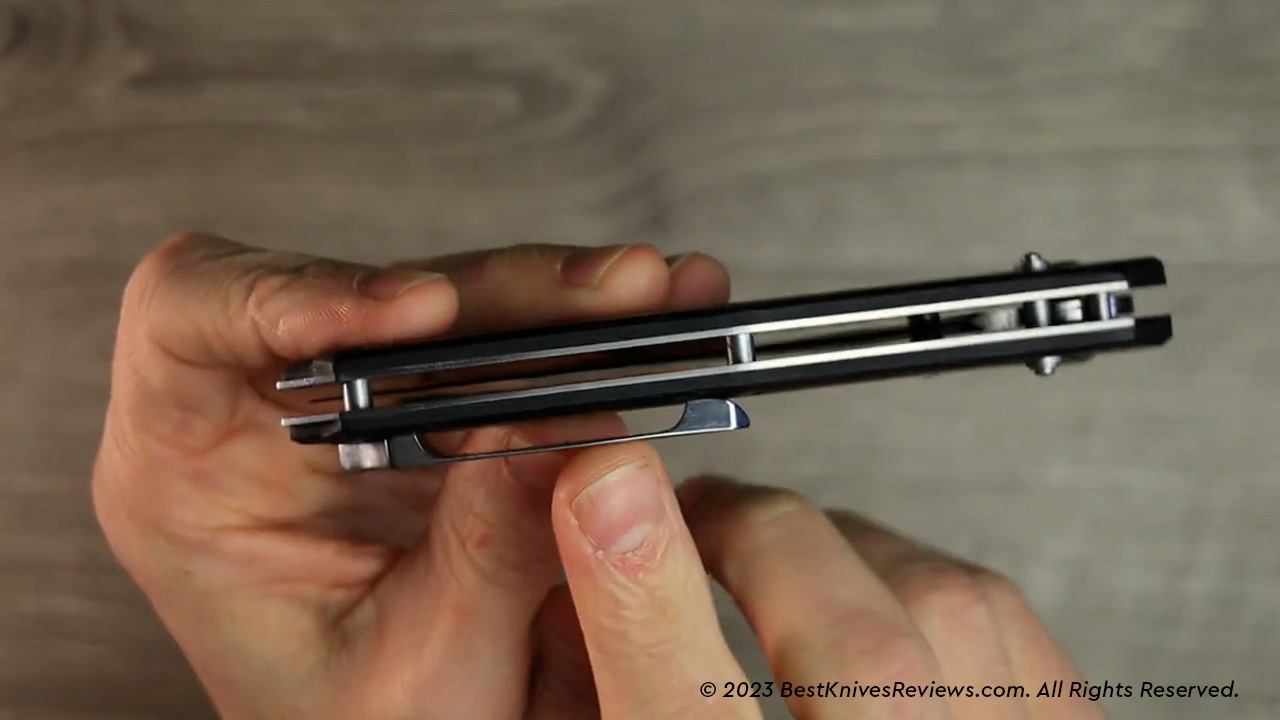
Other than that, the stainless steel liners are also harsh with visible scratches on it. It could easily have been smoothed out with a grit belt sander, which means that this was a manufacturing fault and the knife was harsh right out of the box. These liners are not skeletonized either, and some of the length of these liners was forgone to reduce weight. They could not have been skeletonized because the scales are made out of carbon fiber.
Moreover, the side of the scale with a pocket clip on it has more voids and pits as compared to the other side, which does not make sense. However, the pocket clip itself is well-finished and placed.
On the positive side, the blade is straight in perpendicular position and nicely centered when closed and opened.
The carbon fiber itself is strong yet lightweight material but also expensive. It consists of thin strands of carbon fiber tightly woven together and set in resin. It is carbon fiber reinforced polymer that comes wound around the knife handle and marketed as carbon fiber knife.
However, it is not indestructible and can become brittle over time with use. Since the strands are wound together in one direction, they may start to lose apart if stressed in other directions. It can also crack with sharp impacts.
So the scales may be appealing to look at, but they are not functionally sound.
The pocket clip also did not carry well and felt like it could easily slide off. Although it was able to keep its texture intact. The pocket clip also felt too bulky and unpleasant.
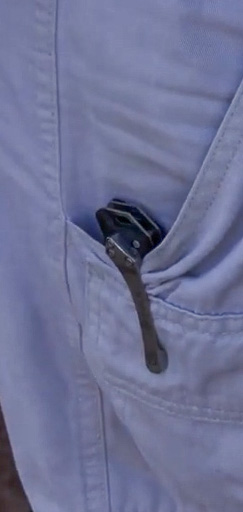
Deployment & Pivot Locking Mechanism of Schrade Radok
The Pivot Lock, also known as Axis Lock, Able Lock, XR Lock and Slide Lock all work the same way. Different knife brands have just given it a different name. Scrade Radok along with Gerber use the term Pivot Lock. It consists of a string bar that slides into place on top of the blade tang to lock it open. It is pretty standard and simple and also used in the Truix folder.
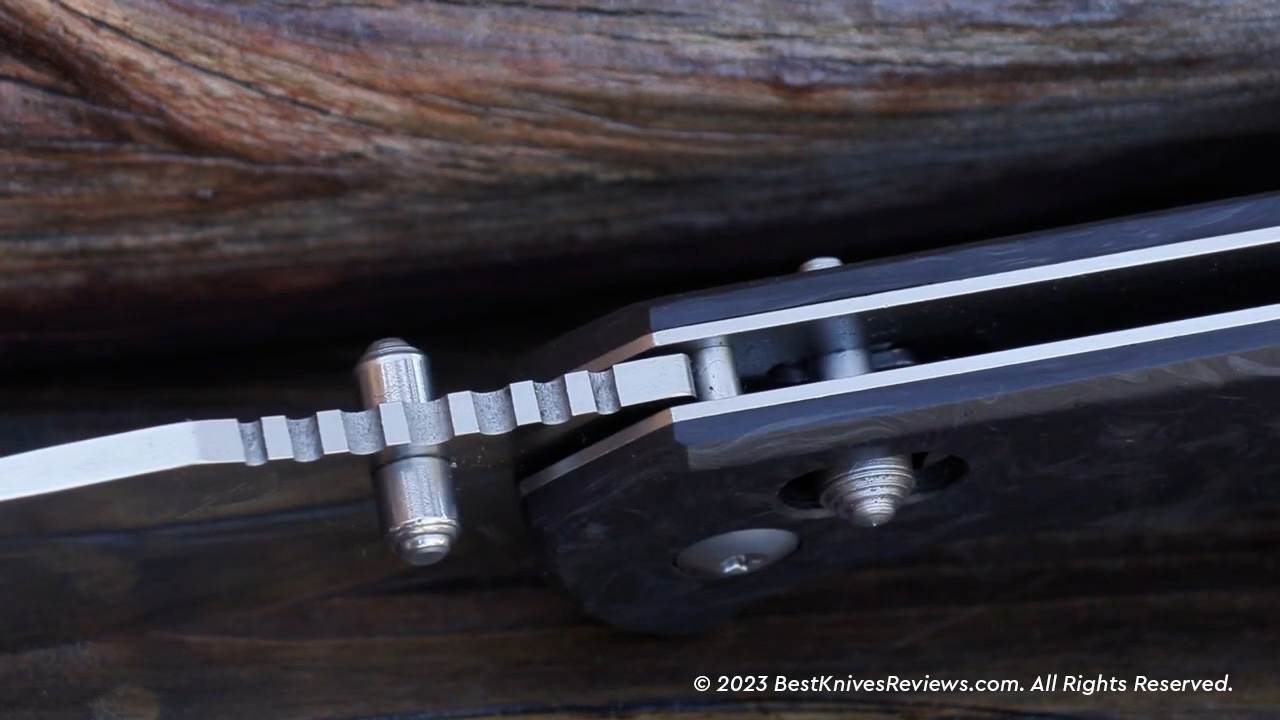
The lockup however, does not show any blade play, but only slight vertical blade play. The pivot tension can easily get rid of the horizontal blade play, but vertical blade play can be hard to get rid of because it is a product of design right out of the box. It closes very smoothly though despite that because of the bearing pivot that is low friction along with the heavy blade that leads to lack of friction when open. It easily closes because of its own weight when you release the lock.

The deployment on this knife is via a couple of ambidextrous thumb studs with ball bearings caged in the pivot of the knife. It gives a smooth flicking action with a light detent. However, the light detent does not go well with a blade as beefy as Radok’s S35VN. It means that the deployment requires a strong flick of the wrist to open. The Radok further uses the external stop pin to disengage the blade in an opening position, and anchored towards the two liners for stability.
Field Test of Schrade Radok
Schrade Radok being a big beefy knife seems like a tool for heavier EDC tasks. Therefore, we tested it first by shredding pieces of wood.
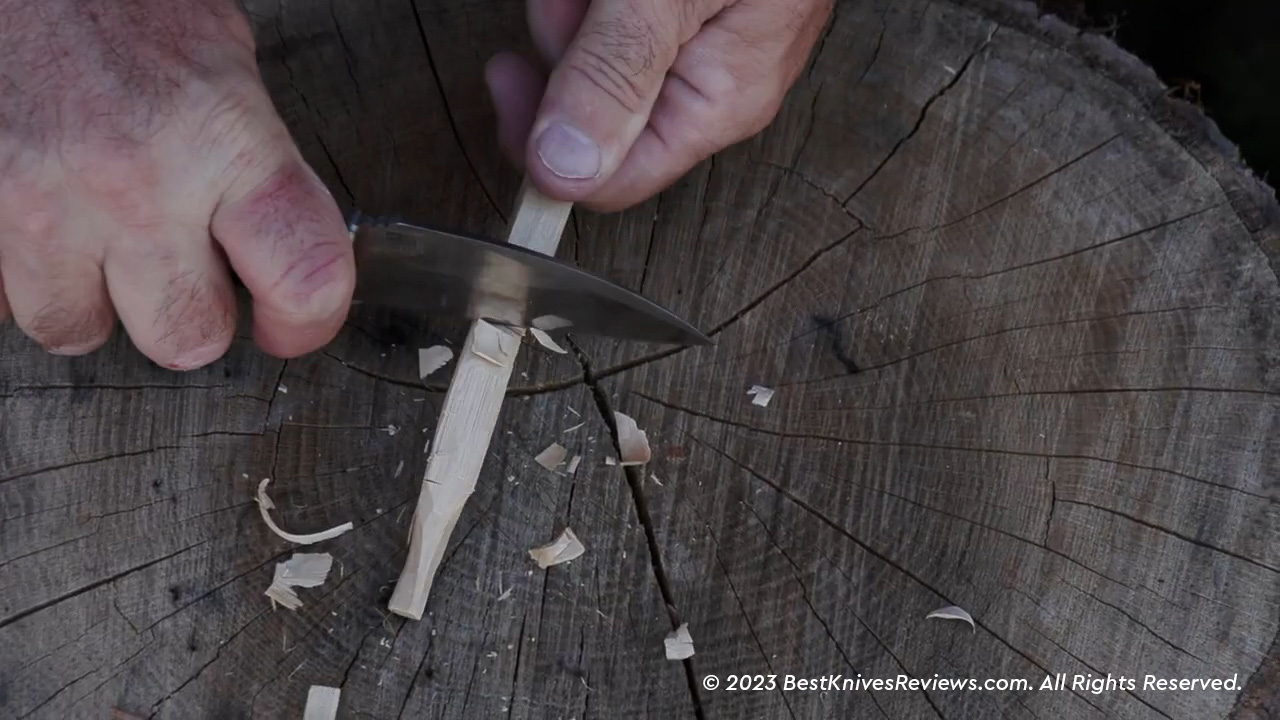
It was able to shred, chop and slice into the dry wooden stick with ease. The thickness of the blade played a major part in wood chopping. It did not exert much pressure into the hand if the hand is skilled in wood chopping.
We then sharpened the knife for extra precision before bringing it back into the field.
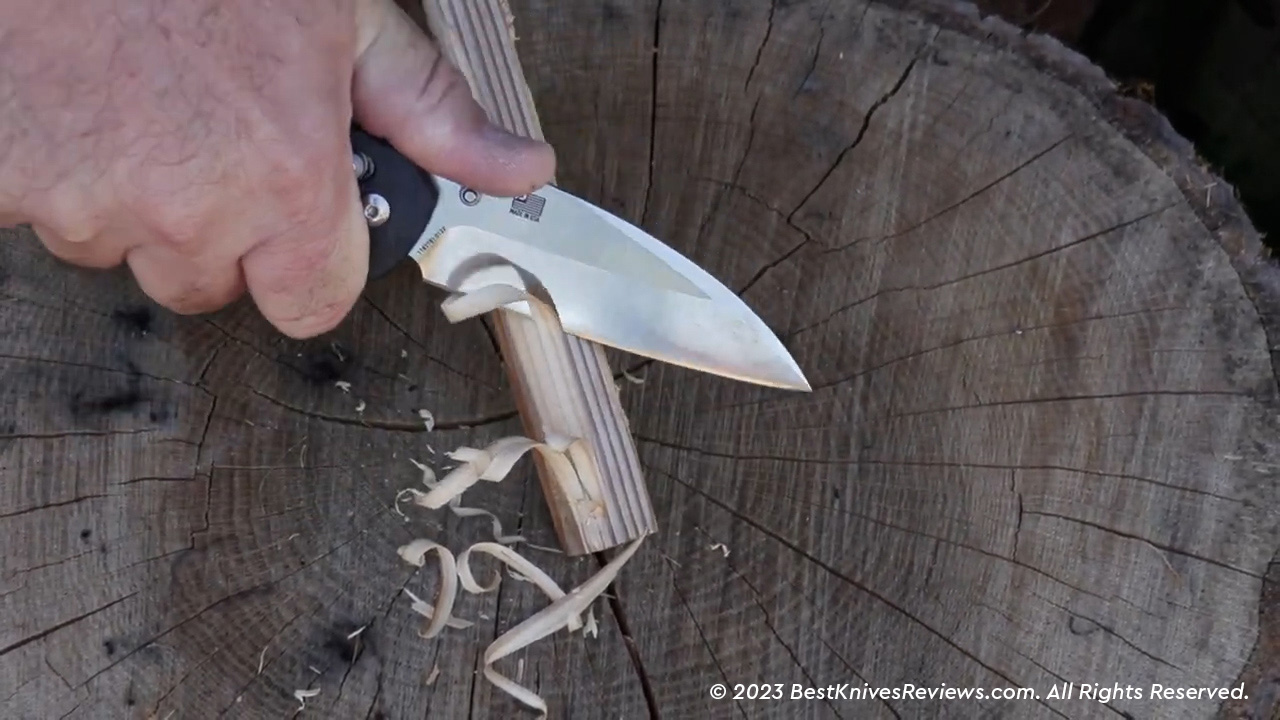
This time, the knife performed better because it was well-sharpened. However, the ergonomics were not as great, as expected from our assessment of the handle. It was too sharp and pinched in the palm, especially while chopping wood and making wood chips.

On the plus side, the deployment was good. The blade flicked open easily, even though it required some extra wrist action. The Wharncliffe blade seems to balance perfectly on this knife, giving it a nice tip and edge. The finger guard on the handle was also well-defined, although the forward finger choil was not as comfortable.
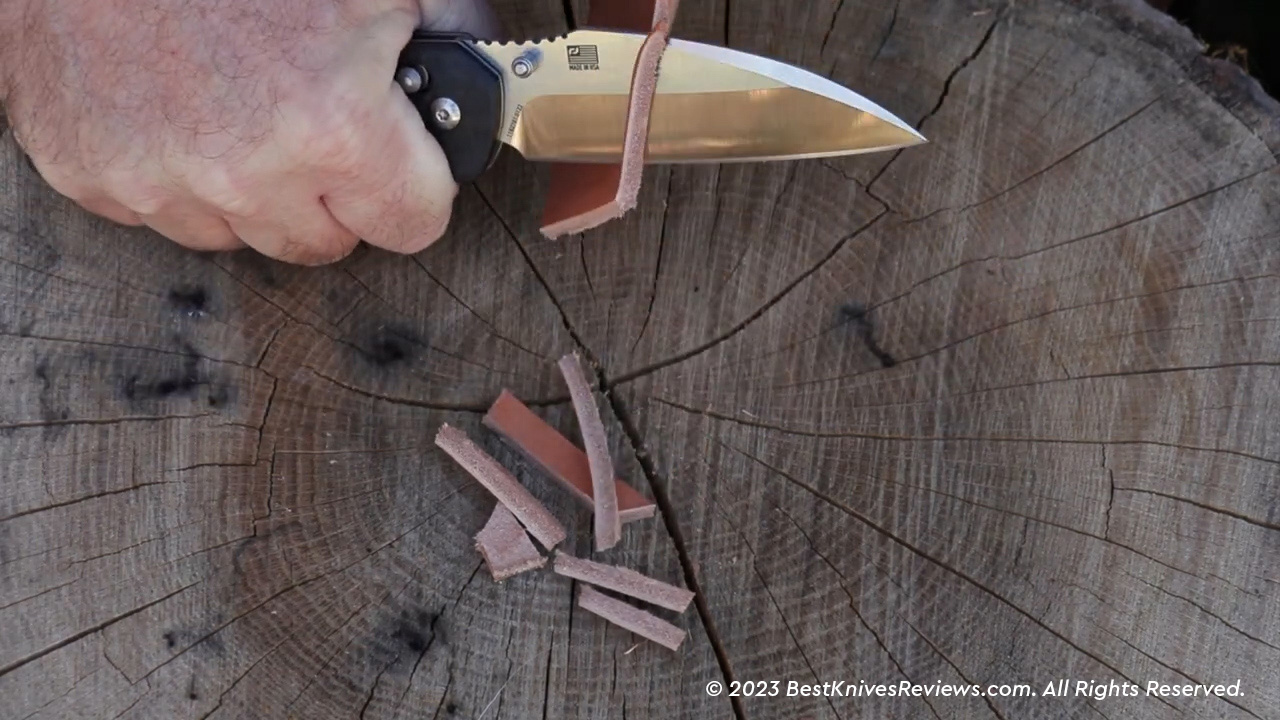
The back of the blade also performed well after sharpening the blade, which was unexpected. It was able to cut right through the wood, even though it was a tough action. Nevertheless, we got the results we wanted, although not as precise.
On the other hand, it proved to be great at packages and box opening. It worked with razor-sharp excellence. It is also great for food preparation and roll cuts. Its curvature and belly makes it perfect for these tasks.
Pros & Cons of Schrade Radok
PRO’s
Con’s
Comparison
Schrade Radok vs Ritter RSK MK1-G2
Schrade Radok and Ritter MK1-G2 have a lot in common. They both share the same lockup and deployment, and are made in the US. They both are big-sized folding knives and weigh exactly the same
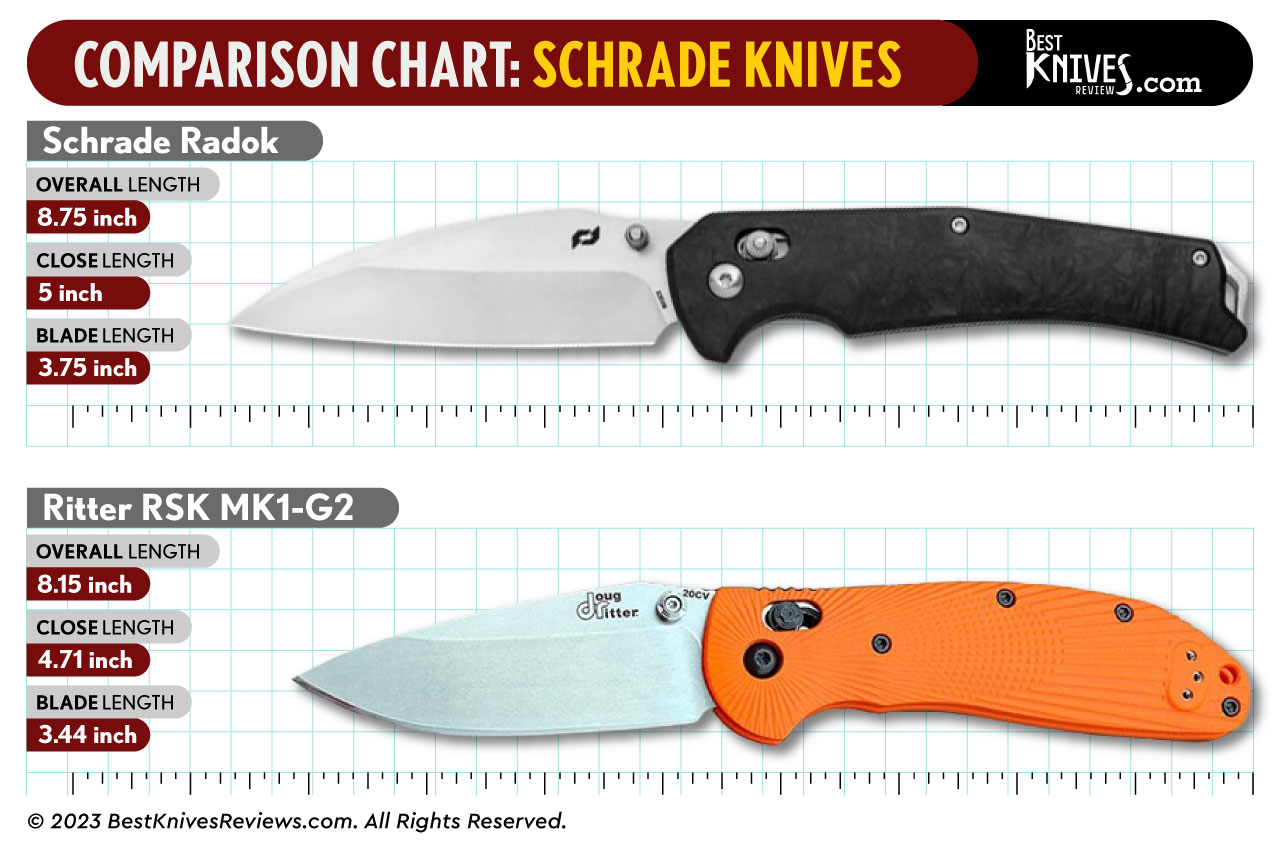
However, Ritter MK1-G2 is a better deal for several reasons. Firstly because it performs better than Radok and costs $100 less than Radok. Secondly because its deployment and lockup is way smoother than the Radok. Thirdly, RSK uses a superior and better functioning blade, CPM 20CV. It comes with a drop point blade that is stonewashed and much more appealing to look at.
More importantly, the ergonomics on the RSK are far superior than those on the Radok, mostly because of the balance between the blade and the handle. The pocket clip is also better and of better quality.
Hence, RSK comes out on top of Radok in terms of price, performance, cutting action and blade and handle material, which is that of G10. You can also consider it as your go-to folding knife at a great price.
Schrade Radok vs Benchmade Freek
Benchmade Freek is also a slightly bigger folding knife that falls under the same price range as the Radok. It also comes with a superior CPM M4 tool steel that is highly corrosion resistant and tough with cerakote finish.
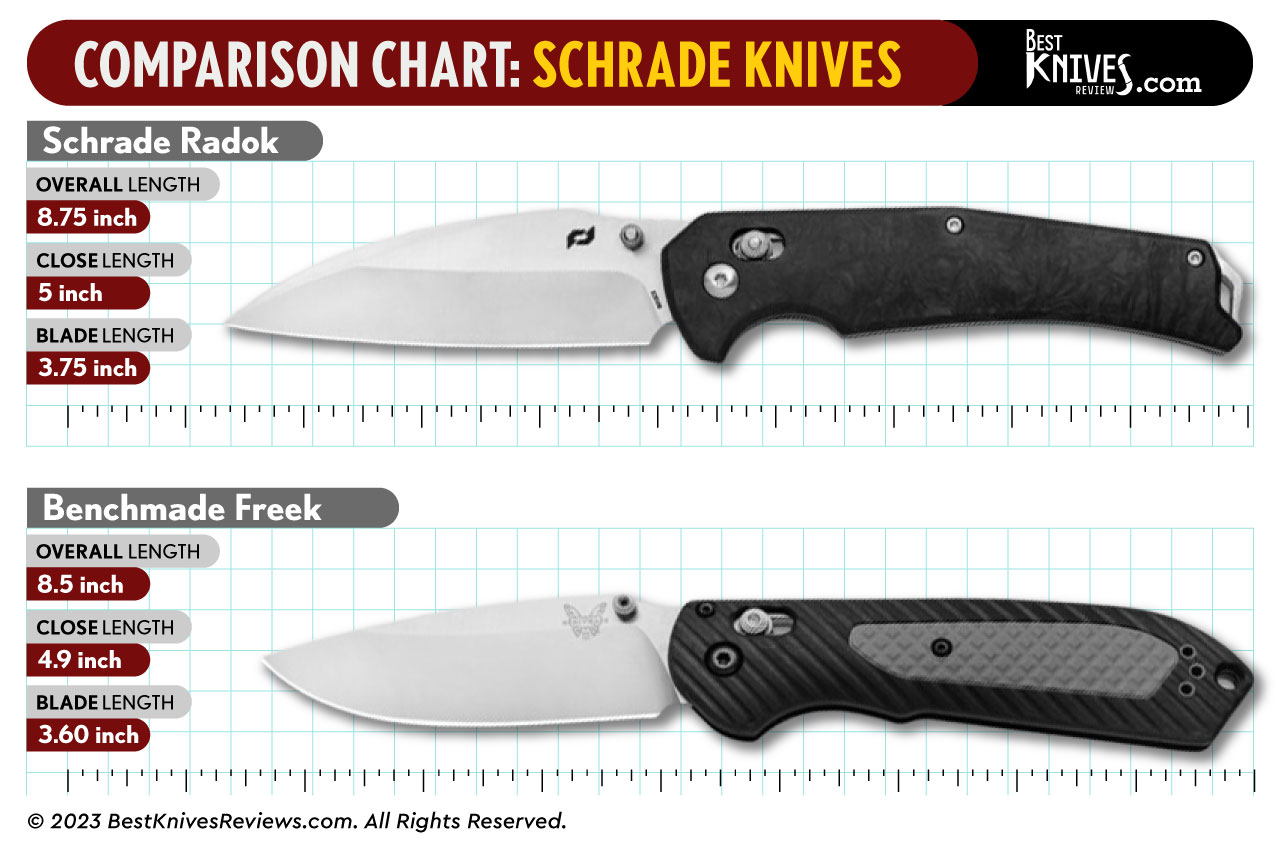
The layered and textured G10 scales with the original and beefy Axis Lock with ambidextrous thumb studs makes this knife a top-notch choice. Its cutting performance is also better than Schrade Radok in terms of excellent ergonomics and handle and blade proportion.
However, Freek weighs less than Radok, with 4.3 oz. and extends up to 8.5”. Its blade shape and geometry is more promising than the Radok. Therefore, Freek is a better folding knife than the Radok.
Concluding Thoughts on Schrade Radok Review
Schrade Radok comes from a long line of corporate knives industry that has a long running history. It falls under the Alpha category of knives. However, it proves that it is not important to belong to a conglomerate knifing industry to be good. It is ridiculously expensive, although on sale for now. But it is not exactly as proportionate and proportional in terms of blade and handle geometry, lockup and pocket clip.

Although S35VN is a superior blade, it does not do justice on this knife. The carbon fiber is also a fine material, but the ergonomics are horrible on it. Moreover, the jimping on the forward finger choil is too sharp. It also had sharp edges that pinch into the palm. The lockup is also not as smooth as we would expect from an original Axis or pivot lock. The deployment was fine, but it also required extra wrist action to flick open the blade.
When compared to Ritter SRK and Benchamde Freek, Radok could not win. The other two knives turned out to be better than this one. Therefore, it is not a good knife overall, and we would not recommend it.